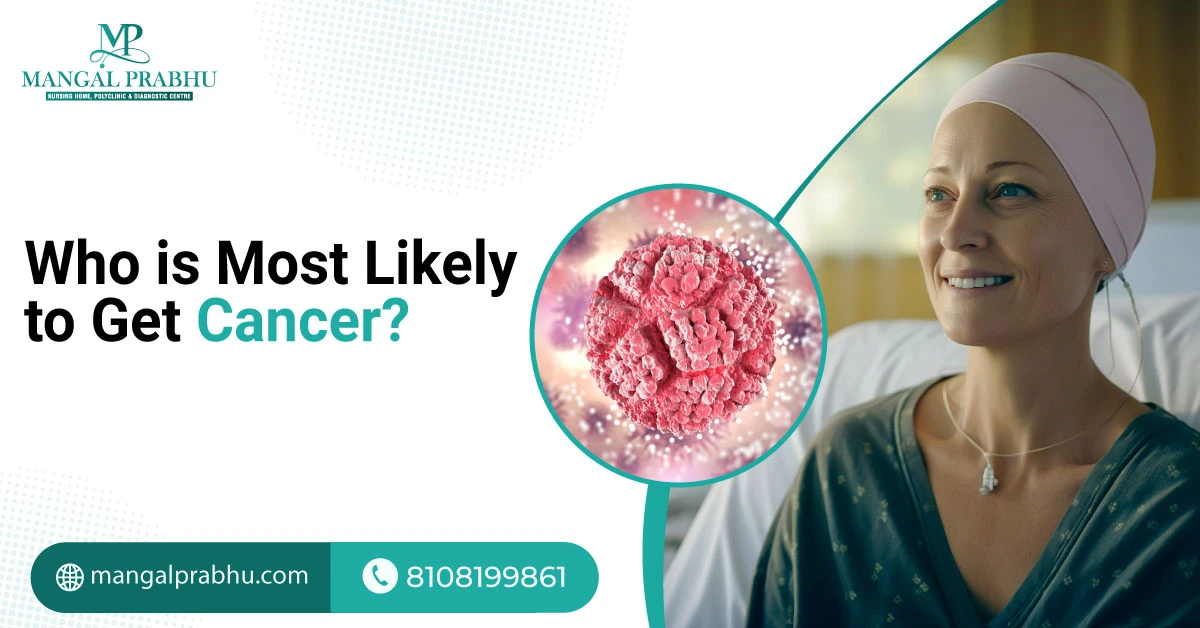
Who is Most Likely to Get Cancer?
Cancer is a severe chronic disease that can affect anyone. The World Health Organization states that 30-50 percent of cancers can be prevented. A cancer specialist in Navi Mumbai believes that your lifestyle choices play a significant role in increasing your risk of having cancer. Quitting smoking and having a healthy physical routine (to name a few) can mitigate this risk. In this post, we’ll take a look at who’s most likely to get cancer and why.
Who is Most Likely to Get Cancer?
i) Genetic Factors
While cancer doesn’t directly pass from parents to their offspring, the gene mutations can be inherited. Certain gene variants might increase your likelihood of developing certain types of cancers.
For example, BRCA1 and BRCA2 gene mutations are linked to an increased risk of breast and ovarian cancers. Mutations in the RB1 gene can cause eye cancer in children. That said, having cancer-related gene variants doesn’t mean you will definitely develop cancer. It only increases the risk. It’s advisable to schedule regular checkups with your healthcare expert just to be on the safe side.
ii) Lifestyle Choices
As mentioned above, certain lifestyle choices are associated with an increased risk of cancer. Here are a few:
a) Smoking and Tobacco Consumption:
These are the biggest risk factors for cancer. Smoking interferes with the cell’s DNA, making them more likely to grow aggressively, forming a tumor. These are linked to throat, mouth, bladder, pancreatic, and lung cancer. Not only smoking but exposure to second-hand smoke may also increase your risk.
b) Diet and Exercise Habits:
Your diet also affects your cancer risk. People eating a high amount of red meat, processed foods, saturated fats, and sugary foods are more likely to develop cancer than those eating healthy and nutritious foods, such as leafy greens, whole grains, and fruits. Living a sedentary lifestyle can also negatively affect your risk of having cancer. It’s advisable to be physically active. This will keep your weight and hormones in check.
c) Alcohol Consumption:
Another preventable risk factor of cancer is alcohol consumption. Alcohol is linked to a heightened risk of throat, mouth, esophageal, colorectal, and liver cancer.
iii) Environmental Exposures
Certain environmental factors, such as sunlight and radiation, can expose you to carcinogens, thus increasing your risk of developing melanoma and other types of cancers. Exposure to toxins in the workplace can also contribute to your risk.
iv) Age and Gender
Most patients get cancer after 50, as DNA damage occurs over time. Cancer risk also depends on gender. Women are more likely to develop breast, ovarian, and cervical cancer, while men are at an increased risk of colorectal, prostate, and lung cancer. That said, young people can also develop it. It’s best to visit the cancer hospital in Navi Mumbai for regular screenings.
v) Medical History
People who have had cancer before are more likely to develop it in the future. Certain types of infections, such as HPV, can heighten your risk. Weakened immunity is also associated with an increased risk of cancer, as it makes you more prone to infections. That’s all about the factors affecting your risk of getting cancer. Although you can’t completely eliminate the risk, certain factors that heighten your risk can be controlled.

How Does Cancer Spread?
What makes cancer life-threatening is its ability to spread to the major organs. No matter where it started, it can travel through your bloodstream or lymph nodes and invade your vital organs. In medical terms, the process is called metastasis. An oncologist in Navi Mumbai provides cancer patients with an accurate diagnosis and a suitable treatment plan.
Simply put, cells from the tumor escape and enter your blood, transporting them to different parts of your body. Research regarding “how does cancer spread” is still going on. The more we know about the process, the more treatment options we can explore for a higher success rate.
How Does Cancer Spread?
Metastasis is a complex process. It starts with local invasion, in which the cancer cells break away from the tumor (in the primary site) and enter the nearby tissues.
From there, they find their way into your bloodstream and lymphatic system. That’s called intravasation. Your immune system kills most cancer cells at this stage, but a few might escape and settle in a new location. They form a secondary tumor there.
Common Sites for Metastasis
The areas invaded by the cancer cells depend on where the cancer starts. For example, cancer starting in the breast will travel to the lymph nodes of your underarms rather than your abdomen.
It also depends on the cancer cell type. These cells tend to settle in locations where they can thrive. Prostate cancer cells prefer your bones, as they offer these cells the environment to grow and spread. Here are the common locations for cancer cells to spread:
- Bladder cancer: Bones, lungs, or liver
- Breast cancer: Brain, liver, and lungs
- Prostate cancer: Bones, liver, lungs
- Lung cancer: Bones, brain, and liver
Most types of cancers spread to the lungs, liver, bones, and brain.
Detection and Diagnosis of Metastatic Cancer
Some cancers are detected when metastasized—already spread to other organs. Here’s the list of tools used for diagnosing metastatic cancer.
a) Imaging Techniques:
CT scans, ultrasounds, MRIs, bone scans, and PET scans are imaging tests that locate cancer cells and show their extent of spread.
b) Biopsy:
If malignancy is suspected, your doctor might extract sample tissues and send them to the lab for testing. These cells are tested for tumor markers or abnormal growth.
Treatment Options for Metastatic Cancer
A cancer Hospital in Navi Mumbai will discuss treatment options based on the originating site of the cancer, where it has spread, and your symptoms. Depending on the location, an oncologist might start with chemotherapy and radiation therapy.
In some cases, these are used in conjunction with hormonal therapy and immunotherapy. These treatment options are designed to kill cancer cells or slow their growth. In some cases, surgical removal of the tumor that has invaded a vital organ may be necessary.
Conclusion
Metastatic cancer, in most cases, is not curable, which is why early detection of cancer is key to a successful treatment. Treatment of metastatic cancer usually focuses on managing symptoms. That said, technological advancements have encouraged professionals to explore new treatment options and therapies to improve patient’s survival rates and quality of life.
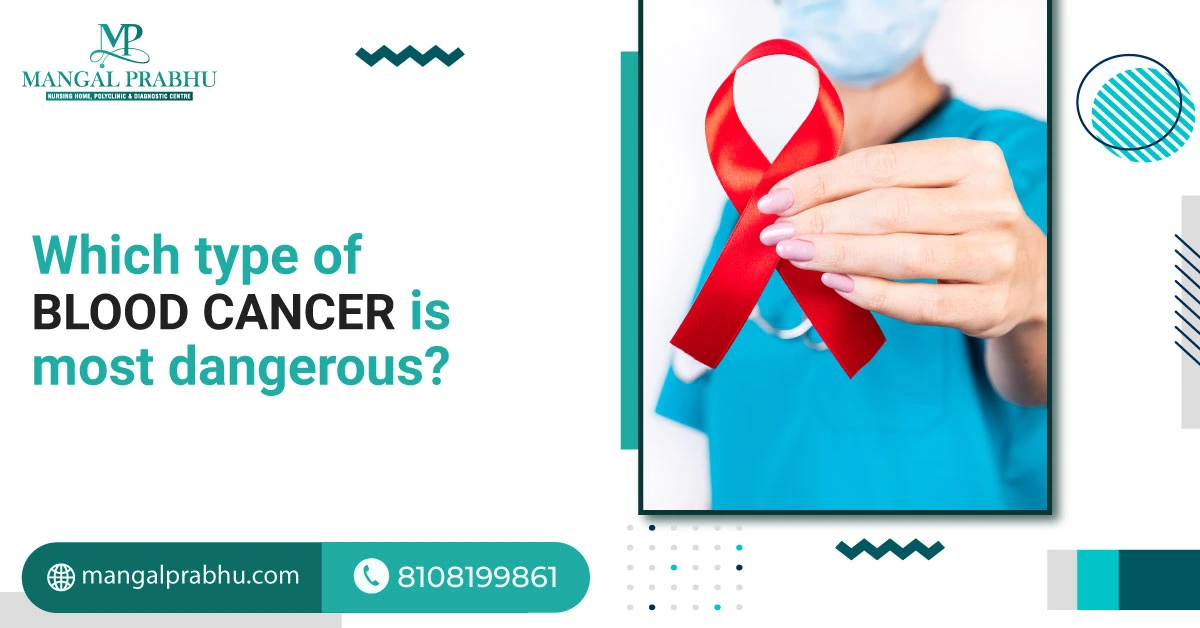
Which Type of Blood Cancer is Most Dangerous?
Blood cancer affects the bone marrow, blood cells, and lymphatic system, which are responsible for protecting the body from infections, circulating oxygen-rich blood throughout the body, and preventing bleeding. The cancer mostly begins in the bone marrow, the tissue that makes blood cells, and spreads to the lymphatic systems and the nearby organs.
Modern science has made certain types of blood cancer curable, including the ones labeled high-risk. However, it’s crucial to seek blood cancer treatment in Navi Mumbai as soon as you notice the symptoms. The success rate of the treatment depends on the aggressiveness of the disease, the type, and how far it’s spread.
Types of Blood Cancer
1) Leukemia:
Leukemia develops in the bone marrow, a spongy tissue responsible for making red blood cells, white blood cells, and platelets. Leukemia is a type of blood cancer that affects your white blood cells. It produces too many WBCs, leaving little room for other healthy blood cells to grow. Leukemia has further subcategories, depending on the type of WBCs affected and how fast it grows.
2) Lymphoma:
As the name suggests, Lymphoma affects your lymphatic system and the white blood cells responsible for fighting infections. In lymphoma, the cancer cells can start to grow in your lymph nodes, spleen, and thymus glands. It can also spread to other parts of the body, impairing your ability to fight off infections.
3) Myeloma:
Myeloma, or multiple myeloma, is a type of blood cancer that affects plasma cells, a type of white blood cells produced in the bone marrow. These cells are responsible for making antibodies, which fight infection. Myolema causes abnormal plasma cells to grow uncontrollably, leaving less room for the healthy cells to develop.
Most Dangerous Type: Acute Myeloid Leukemia (AML)
Many factors determine the danger level associated with blood cancer. However, many hematologists in Navi Mumbai believe that Acute Myeloid Leukemia (AML) is the most dangerous of all. Here’s why.
Among the three types of cancers listed above, the Acute Myeloid Leukemia is the most dangerous, as it spreads quickly to the brain, liver, and other vital organs, increasing the risk of organ failure.
Its aggressive growth is also linked to lesser production of healthy blood cells in the bone marrow. Even if the cancer is treated, acheiving a complete remission is quite challenging, especially in children, older people, and those with existing medical conditions.
Since the cancer spreads rapidly, the symptoms also appear quickly. You will notice increased bleeding, frequent infections, excessive fatigue, bone and joint pain, weight loss, and other relevant symptoms that become noticeable over days and weeks.
Treatment Options for Blood Cancer
The treatment includes chemotherapy with targeted therapy and stem cell transplant. The five-year survival rate for people with AML is 28%, although the numbers can vary depending on your age, health, how early the cancer is diagnosed, and if there’s any existing medical condition. Ideally, the sooner it’s detected, the higher the chances of a cancer-free life. Even if the treatment is succesful and there is no sign of cancer, your doctor will closely monitor you to ensure it doesn’t recur.
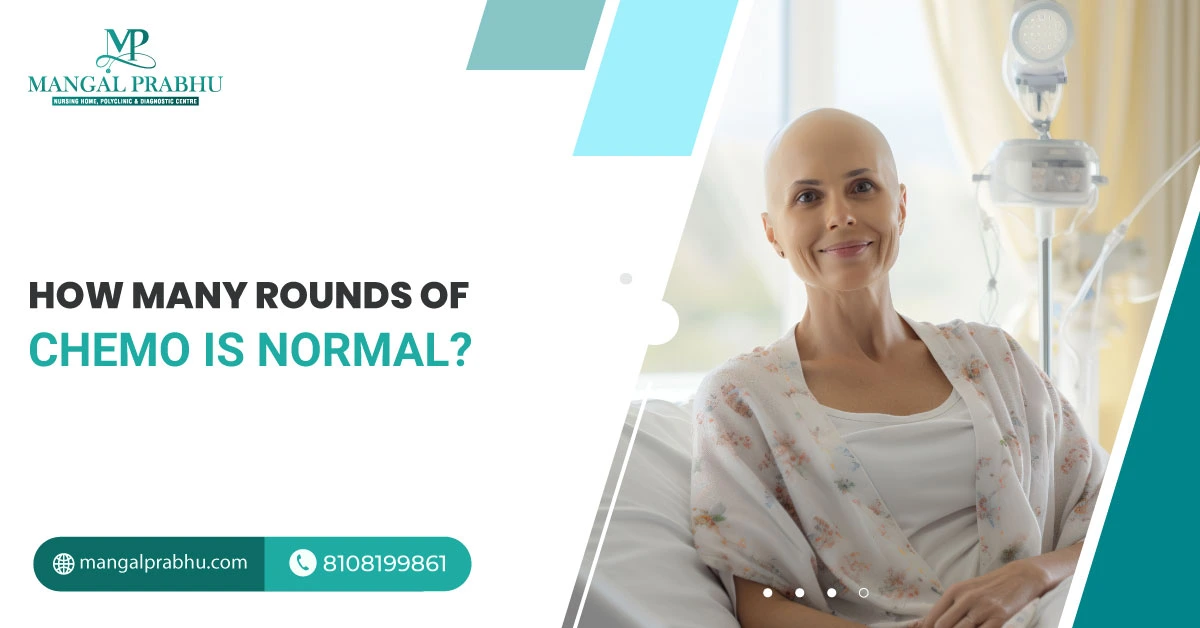
How Many Rounds of Chemo is Normal?
Chemotherapy is one of the effective treatments for many types of cancer. These drugs, combined with radiation therapy, immunotherapy, hormone therapy, and surgery, are administered to prevent cancer from spreading and growing. A cancer specialist in Navi Mumbai recommends chemotherapy in multiple cycles.
This is to ensure that your body gets enough rest before the next cycle begins. It also helps assess how your body and the cancer responds to the medication. In this article, we’ve discussed all you should know about factors affecting chemotherapy duration, how many rounds of chemo is normal, and the chemo cycles. Let’s take a look:
Factors Influencing the Number of Chemo Rounds
The number of chemo sessions you need depends on many factors:
i) Type of Cancer:
Breast and lung cancer, for example, require 4-6 cycles of chemotherapy. Chronic leukemia may require ongoing chemo sessions that can last up to 2 years.
ii) Stage of Cancer:
Cancer that’s diagnosed at an early stage might require fewer chemo rounds compared to the advanced-stage cancer that’s spreading aggressively. Your treatment plan may include chemo sessions before and after surgery.
iii) Patient’s Health:
How your body reacts to the chemo drugs determine the number of chemo rounds required. If your tumor shrinks and your symptoms improve, the oncologist may recommend fewer sessions. If the progress is slow, more rounds might be scheduled.
Typical Chemotherapy Schedules
A normal range for chemotherapy rounds is between 4 and 6 cycles, but as mentioned above, it can vary from patient to patient, depending on the type and stage of cancer. Usually, the sessions start with chemo drugs, which are administered over a few days and are followed by a rest period of 2-3 weeks before another chemo session is planned.
Experts advise that chemotherapy drugs must be given with a rest period, as these medications can kill your fast-growing healthy cells. It’s a common side-effect of chemotherapy. So, while the treatment works wonders for cancer patients by killing the rapidly multiplying cancer cells, it also affects the cells responsible for your hair growth, cells in your mouth, gut, and other places. Your body needs adequate time to replenish these healthy cells.
Individualized Treatment Plan
Treatment is mostly personalized based on the patient’s age, type of cancer, and its aggressiveness. If needed, the chemotherapy regimen can be changed. The doctor decides whether to continue or how the future sessions should be planned based on how your cancer responds to the first few cycles.
Managing Side Effects
The most common side-effects after chemotherapy include fatigue, sore mouth, hair loss, nausea, vomiting, diarrhea or constipation, neuro pain, cognitive issues, weight loss, and low immunity.
Chemotherapy treatment in Navi Mumbai is associated with many side-effects, some of which can cause extreme discomfort and might interfere with your daily activities. Talk to your doctor if the side-effects get severe. They will recommend lifestyle modification, change medication, or switch your chemo regimen to manage side-effects. There’s no exact chemotherapy count. You may need only a couple of sessions to kill cancer completely. Others may need more for the best results.
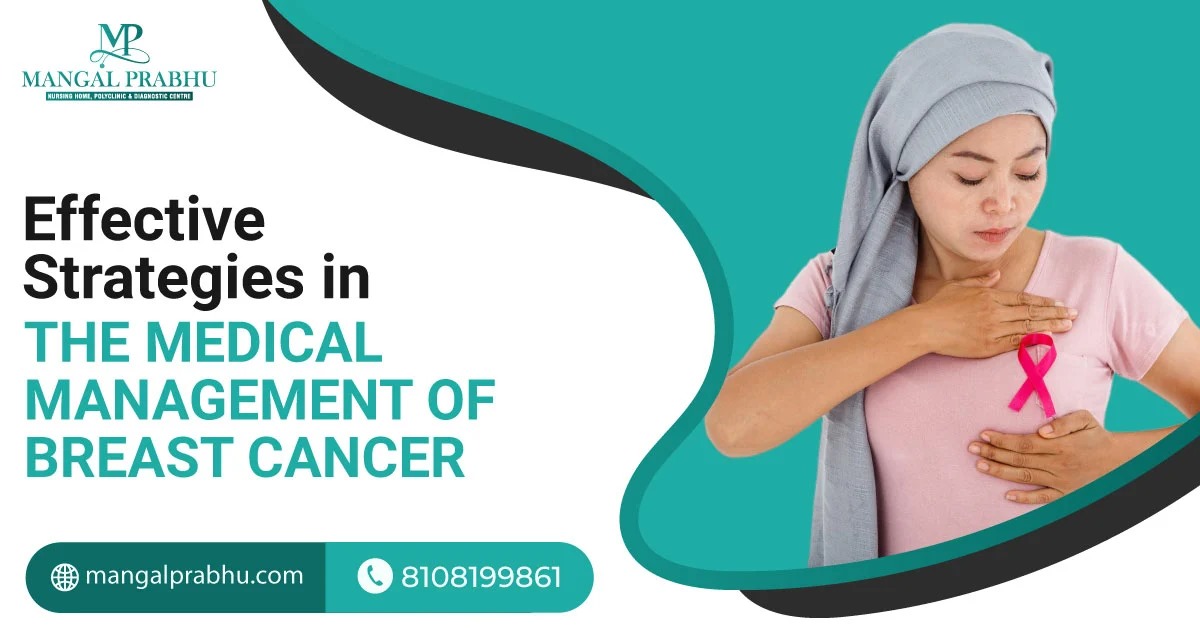
Effective Strategies in the Medical Management of Breast Cancer
Breast cancer diagnosis can be emotionally and physically challenging. However, advancements in technology and medical science have improved the survival rate and quality of life of many cancer patients. Depending on the stage of the cancer, breast cancer treatment in Navi Mumbai may involve surgery as a standalone procedure or combined with chemotherapy, radiation therapy, and hormone therapy.
In this post, we’ve explored some effective strategies in the medical management of breast cancer. Keep reading.
Early Detection and Diagnosis
The 5-year survival rate of women with breast cancer is 99% if it’s localized, i.e., if it hasn’t spread to the surrounding tissues and lymph nodes. The same is 86% for patients with regional breast cancer and 31% if it’s distant or has spread outside the breast tissue.
Screening Methods
Your health professional will conduct a thorough breast examination to detect any visible lumps that could be cancerous. They will also look at your breasts to check if your nipples and breasts look normal. Here’s what else can be used for detecting breast cancer.
1) Mammogram:
This is a type of breast X-ray that examines both breasts closely. If the mammogram shows anything unusual, another one will be ordered. This gives a detailed look at your breast tissues.
2) An Ultrasound:
Your healthcare provider may recommend a breast ultrasound, which can differentiate between a fluid-filled cyst and a cancerous mass. The doctors will decide whether further screening is needed depending on the test result.
3) MRI:
For an MRI, the patient is injected with the dye that gives a clear picture of both your breasts. This imaging test is used to detect how far the cancer has spread.
4) Biopsy:
A small sample of the breast tissues is used to detect cancerous growth.
Treatment Options
Your oncologist in Navi Mumbai might recommend the following treatment options:
a) Surgery
For most types of early-stage breast cancers, surgery is the most effective option. It’s possible to remove the tumor completely. This will prevent the likelihood of the cancer recurring. The surgery is called lumpectomy. If the tumor is large, a mastectomy (complete or partial removal of the breasts) might be needed.
b) Chemotherapy and Radiation Therapies
Chemotherapy can be given before surgery to shrink the tumor size, making it operable. It could be needed after surgery, as well. If cancer has spread beyond the breasts and has entered lymph nodes and nearby organs, chemotherapy, and radiation therapies followed by tumor removal are recommended.
c) Targeted Therapies
A targeted therapy attacks cancer cells by destroying the chemical mechanism in these cells. These are highly effective and have fewer side effects, as targeted therapies cause minimal damage to healthy cells. Most targeted therapies destroy the cancer cells that make extra HER2 (a protein responsible for the growth of cancer in your body).
d) Immunotherapy
Immunotherapy can be used for triple-negative breast cancer. The therapy signals your immune system to find and kill cancer cells. These treatment options are often used together to destroy cancer cells, slow their growth, and remove the mass from your breasts.
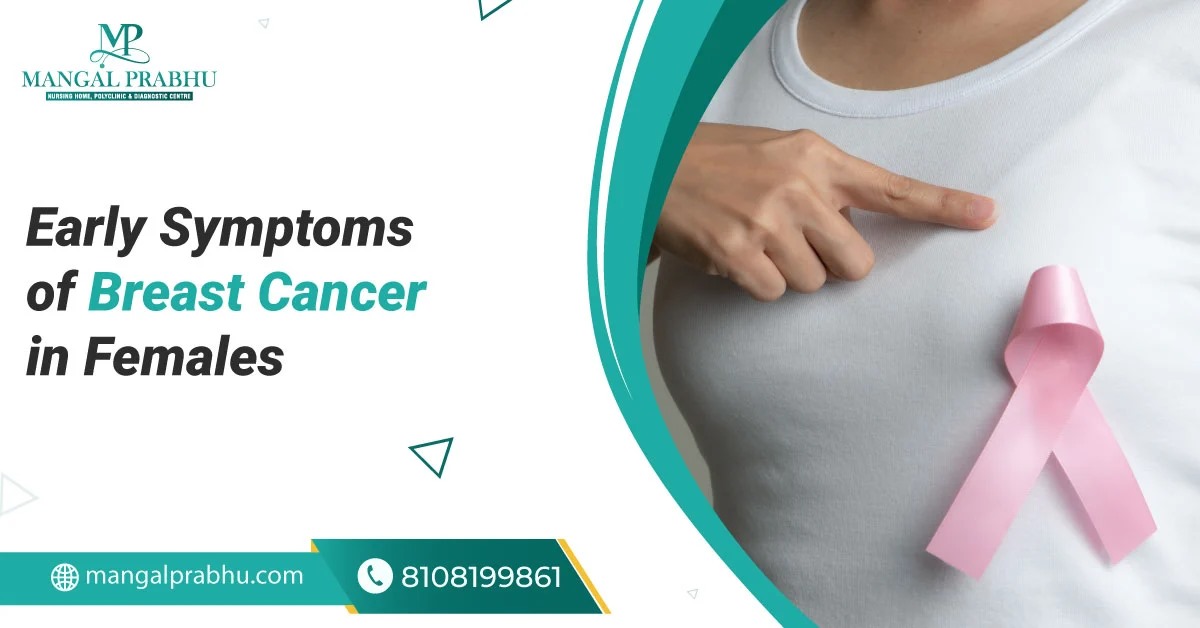
Early Symptoms of Breast Cancer in Females
Breast cancer occurs when the cells in your breasts start growing abnormally. It’s one of the most common types of cancer in women all over the world. Although it mainly occurs in women, a report by the World Health Organization (WHO) shows that 0.5 to 1 percent of breast cancers affect the male population.
Like any type of cancer, breast cancer can spread to the surrounding tissues and organs, and even lymph nodes when it reaches an advanced stage. Early detection followed by breast cancer treatment in Navi Mumbai can increase your survival rates.
Early Symptoms of Breast Cancer in Females
The survival rates in women diagnosed with breast cancer have been improving. That’s primarily because people are now more aware of the symptoms, and they get prompt medical care, which improves the treatment outcome.
As mentioned above, early detection is key to getting the best treatment. Here are the initial signs of breast cancer you must watch out for:
1) Breast Lumps
The first and most common sign of breast cancer is a visible lump that may have rounded or uneven edges. You must practice self-examination to spot any lumps on your breasts. Women above 40 and those with a family history of breast cancer should get mammograms every year, even if there’s no lump or pain.
2) Changes in Breast Size and Shape
If one or both of your breasts appear considerably larger or smaller than before, that’s a sign you should see a healthcare specialist immediately. Breast cancer can cause asymmetrical breasts. Changes in the nipples and their symmetry can also be the early sign of breast cancer.
3) Skin Changes
Several noticeable skin changes on your breasts can also indicate breast cancer. The most common changes include a visible dimple-like spot on the skin, puckering and scaling, and a red rash. Some women report swelling on their breasts and near the armpits before it turns into a visible lump.
Less Common Symptoms
When the cancer reaches an aggressive stage, you might experience advanced symptoms, like a clear discharge from one or both nipples. It can be whitish, yellow, green, or bloody. Any kind of discharge from your nipples, which isn’t milk, should be reported to the doctor.
i) Inverted Nipple
If you were born with inverted nipples, that’s usually not a cause for concern. However, if you notice a sudden inversion, especially in one of the nipples, it can be a sign of breast cancer. Nipple inversion can also indicate a benign condition, though. It’s best to get evaluated.
ii) Breast Pain
Breast pain can occur from many benign conditions. Hormonal changes, puberty, onset of menstruation, menopause, and breastfeeding are a few common causes of breast pain in women. However, if it’s persistent and accompanied by other symptoms mentioned above, see a gynecologist for a thorough evaluation.
When to See a Doctor
A visible lump on your breasts with nipple discharge, pain, and swelling might indicate breast cancer. You must schedule an appointment with an oncologist in Navi Mumbai to know whether it’s a benign condition or cancer. They will order a mammogram—a breast X-ray that detects cancer and its stage.
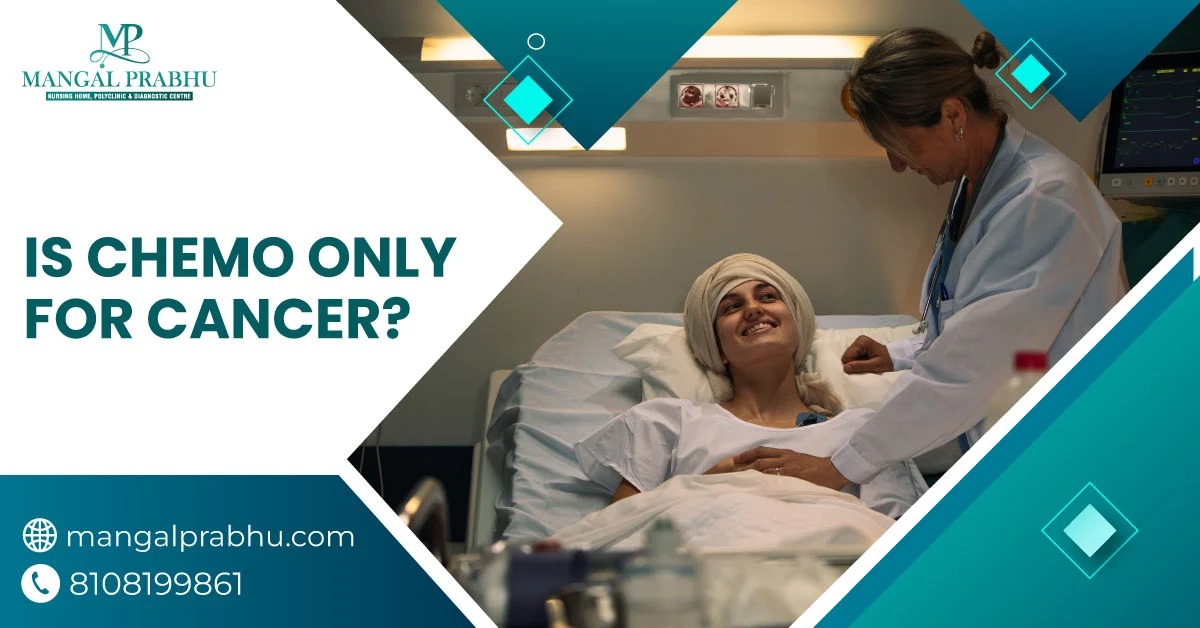
Is Chemo Only for Cancer?
What’s the first word that comes to your mind when you hear the word chemotherapy? Cancer. Chemotherapy is the most common treatment for different types and stages of cancer. Depending on the severity of the cancer, oncologists in Navi Mumbai perform chemotherapy either as a standalone treatment or in conjunction with surgery, radiation therapy, hormone therapy, and other procedures.
The question is, is chemotherapy only for cancer? No! It’s also used to treat certain autoimmune disorders and blood disorders. Let’s see what chemotherapy can treat.
Common Uses of Chemotherapy
For Cancer
More than a hundred types of chemotherapy drugs are used to treat different types of cancer. Cancer cells are known for multiplying rapidly. The initial stage of cancer is often confined to a specific organ, but it can spread to the surrounding tissues, lymph nodes, and organs if left untreated. Treatment gets harder as the cancer reaches an advanced stage.
Chemotherapy drugs kill the rapidly multiplying cancer cells. The goal of the treatment is to stop the cancer cells from growing or replicating. The number of chemotherapies required for each patient can vary depending on their cancer diagnosis and how far it’s spread.
For Non-Cancerous Diseases
Chemotherapy can be used in low doses or high doses for non-cancerous conditions, especially autoimmune disorders.
i) Autoimmune Disorders:
Lupus and other autoimmune disorders, in which your immune system attacks your organs and tissues, can be treated with chemotherapy. The therapy can suppress an overactive immune system.
ii) Bone Marrow Disorders:
Bone marrow diseases in which your bone marrow fails to produce adequate red blood cells might require chemotherapy combined with blood transfusion and bone marrow transplant. Chemotherapy is often performed before a bone marrow transplant to destroy the damaged bone marrow cells.
iii) Infections:
Some types of severe and persistent fungal infections can be treated with chemotherapy. Antifungal agents are used to offer relief to the patient. Viral infections that do not respond to the antiviral medication might also require chemotherapy, especially in patients with compromised immune systems.
Potential Side Effects of Chemotherapy
As mentioned earlier, chemotherapy kills cells that grow rapidly, which might also include the healthy cells in your gut and those responsible for your hair growth. So, side effects are not uncommon after each session. The severity of the side effects and how long they last depends on the chemo drugs you are given and the dosage. Here are possible side-effects of chemotherapy:
- Fatigue
- Hair loss
- Mouth sores
- Memory loss (also called chemo brain)
- Fertility issues
- Nausea and vomiting
- Loss of appetite
- Diarrhea or constipation
The side effects can vary from person to person. These are short-term issues that resolve on their own once the treatment stops and the new cells start to grow. Chemotherapy is also associated with long-term side effects, such as damage to your vital organs, like the heart, lungs, and reproductive system.
Conclusion
You can learn more about different types of chemotherapies and multiple methods used to administer the chemotherapy drugs into your body at the chemotherapy hospital in Navi Mumbai.
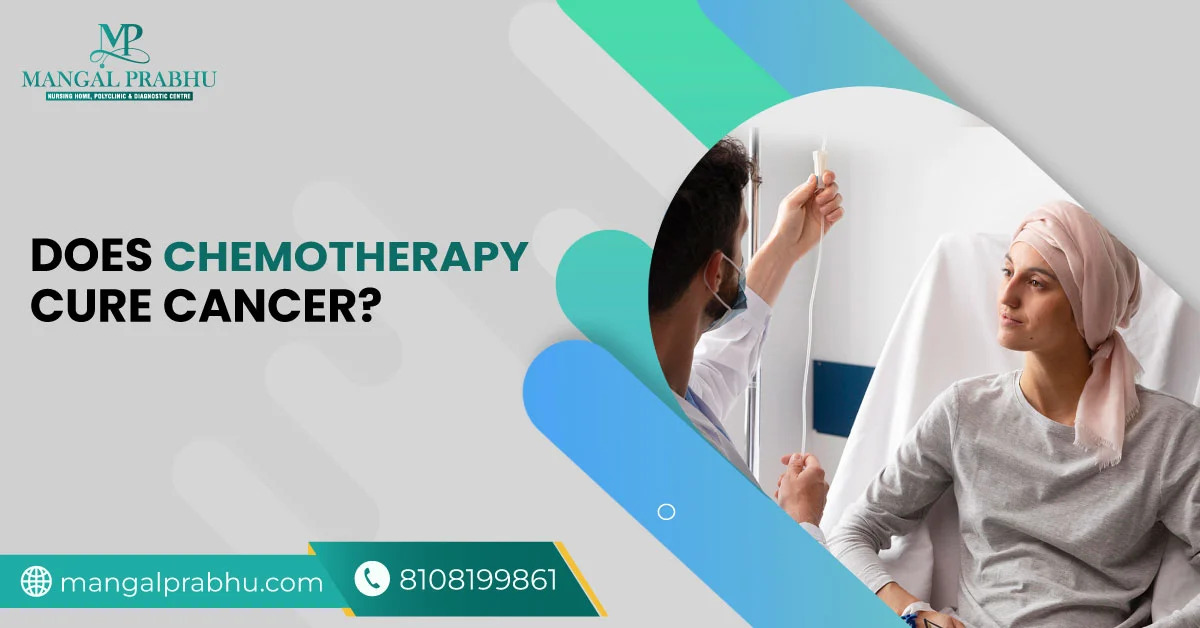
Does Chemotherapy Cure Cancer?
Recovery from cancer is not a cakewalk. The first thing that strikes our mind when it comes to cancer is chemotherapy. It’s a treatment used to kill cancer cells through intravenous administration of the drugs.
These drugs are designed to destroy the rapidly multiplying cells, thus inhibiting cancer growth. While chemotherapy treatment in Navi Mumbai is quite effective in treating cancer, the procedure comes with many side effects. Besides, there’s no guarantee it will cure cancer and prevent relapse.
How Chemotherapy Works
Depending on the type and stage of cancer, chemotherapy can be used as a standalone procedure or in conjunction with radiation therapy and surgery. It can shrink the tumor and destroy cancer cells. Most chemotherapy drugs are given intravenously, but your doctor might recommend a topical application, a single injection shot, or pills.
An oncologist in Navi Mumbai will tell you the number of chemotherapy sessions you need to undergo to kill cancer. Then, based on how your body responds to the treatment, your doctor will either stick to the plan or advise additional treatment, such as surgical removal of the tumor, radiation therapy, or hormone therapy, for the best outcome.
Effectiveness of Chemotherapy
The effectiveness of chemotherapy can vary for each patient. It depends on the type of cancer, the patient’s overall health, the size of the tumor, and how far it’s spread. However, studies show that those exposed to chemotherapy have a better survival rate than those who never undergo chemo. The sooner you report your symptoms and get an accurate diagnosis, the higher your survival rates.
Note that cancer can return even after you are declared cancer-free. Some types of cancer have a chance of relapse, requiring more rounds of chemotherapy. Your oncologist will schedule regular follow-up visits to ensure the cancer has not returned.
Limitations of Chemotherapy
The chemo session isn’t always painful, especially not for those taking it through pills and topical. Intravenous chemo and injections can hurt a little, but it’s nothing more than a slight burning sensation.
Chemotherapy is used to destroy the rapidly growing cells in your body. That’s how it helps kill cancer fast. However, cancer cells are not the only cells that multiply quickly. The cells in your skin, hair follicles, digestive tracts, and other parts of the body also grow fast.
Cancer treatment can also destroy these healthy cells, leading to side effects such as hair loss, fatigue, constipation, diarrhea, vomiting, loss of appetite, and infection. The good news is that the side effects of chemotherapy last for a short while, usually until your treatment stops. Some side effects are, however, permanent. They include infertility, heart problems, and early menopause.
Conclusion
Chemotherapy is an effective way to kill cancer, but the treatment comes with side effects and is usually advised with surgery and other procedures. Ask your oncologist about the success rate of chemotherapy and the side effects. Fortunately, some types of cancer disappear completely following the chemotherapy and don’t require additional treatment. But there’s always a chance of a relapse.
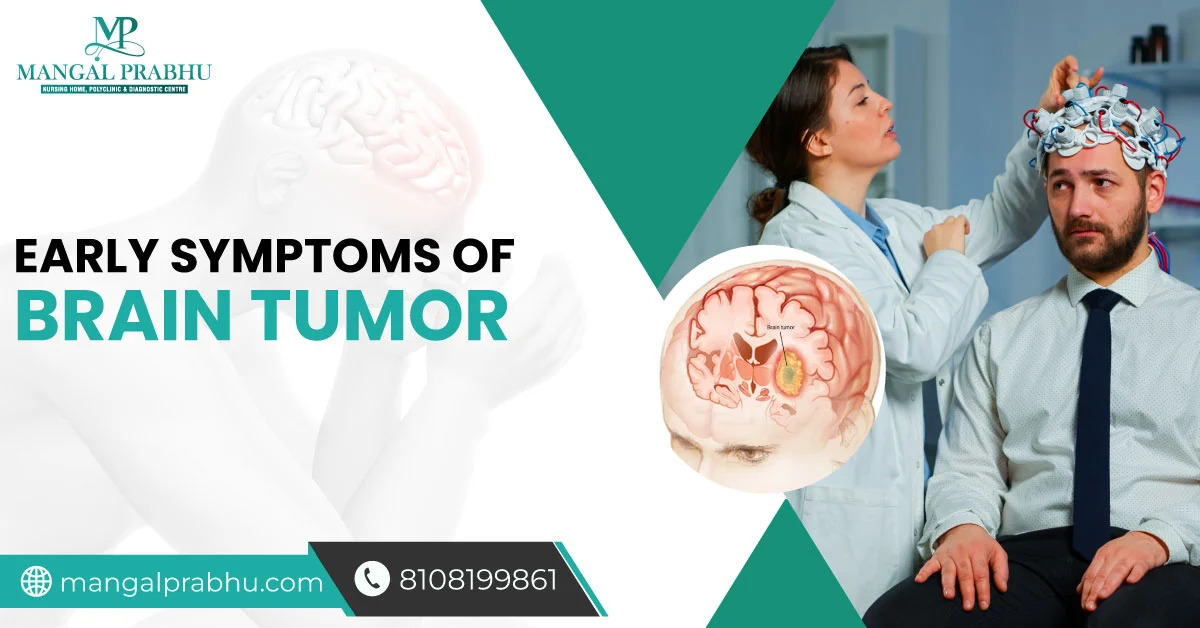
Early Symptoms of Brain Tumor
Brain tumours refer to unexpected growths originating from any part of the skull and could be malignant or benign. As in most diseases and sicknesses, the early diagnosis greatly helps in managing the disease. This article is meant to focus on some of the frequent early signs of brain tumors that should make one get medical assistance from a Cancer Specialist in Navi Mumbai.
Common Early Symptoms of Brain Tumors
This chronic headache is one of the first signs of brain tumor and can occur at any age. This is because a Cancer Specialist in Navi Mumbai may find a tumor when analyzing severe or frequent headaches or headache, which is different from other headaches.
Another symptom might be seizures, which would also indicate that one could have a tumor in the brain. Other forms of manifestations could be associated with seizures as a part of the picture that occurs with a brain tumour because this is a condition that can affect the normal functioning of the brain. Thus, only when a doctor was capable of detecting it in the initial stages, tumor removal treatment in Navi Mumbai is possible.
Cognitive and Personality Changes
Cognitive and personality changes may arise from a growing brain tumor as it begins to press on brain tissue. Problems with memory, concentration, multitasking or mood changes could point to a tumor. Family members often first notice subtle differences in thinking or behavior before the patient. Seeing a Cancer Specialist in Navi Mumbai can help identify if changes are caused by a brain tumor.
Less Common Early Symptoms of Brain Tumors
1) Vision Problems
Vision problems can sometimes be an early sign of a brain tumor, depending on its location. Issues like blurred or double vision, loss of peripheral vision or other vision changes need medical review, especially if they develop or worsen gradually over time. An ophthalmologist may refer patients for scans to check for an underlying tumor.
2) Balance and Coordination
Balance and coordination issues can arise if a tumor affects motor functions in the brain. Symptoms like dizziness, loss of balance or impaired hand-eye coordination warrant evaluation by a doctor. Neurological testing and scans may reveal a tumor that needs tumor removal treatment in Navi Mumbai for best outcomes.
3) Speech Difficulties
Speech difficulties can be subtle at first but warrant attention, as tumors in speech areas can impact verbal communication abilities over time if left unaddressed. Seeking care from a Cancer Specialist in Navi Mumbai can help identify if slurred or otherwise unusual speech may signal a brain tumor. Early detection increases options for treatment.
When to See a Doctor
Importance of seeking medical attention for persistent symptoms
Anyone experiencing persistent, recurrent or worsening headaches, seizures, cognitive or behavioral changes should see their primary care physician. Other focal neurological symptoms like vision, speech or coordination issues lasting more than a few days also require medical evaluation. It’s especially important to seek care if multiple, otherwise unexplained symptoms appear together or gradually over weeks to months.
Doctors will conduct thorough examinations and may order tests like blood work, MRI scans or other imaging to check for possible causes. While tumors are rare, detecting them early through evaluation increases chances of complete tumor removal treatment in Navi Mumbai by specialist doctors. Early care avoids potential complications from undiagnosed tumors.
Conclusion
Brain tumors can cause subtle symptoms in their early stages. It’s important not to ignore new, recurring or worsening neurological problems. Seeing a Cancer Specialist in Navi Mumbai ensures thorough assessment and testing that may uncover tumors at their earliest and most treatable phases. Early detection allows time for tumor removal treatment in Navi Mumbai before large size or complicated positioning impacts treatment options.
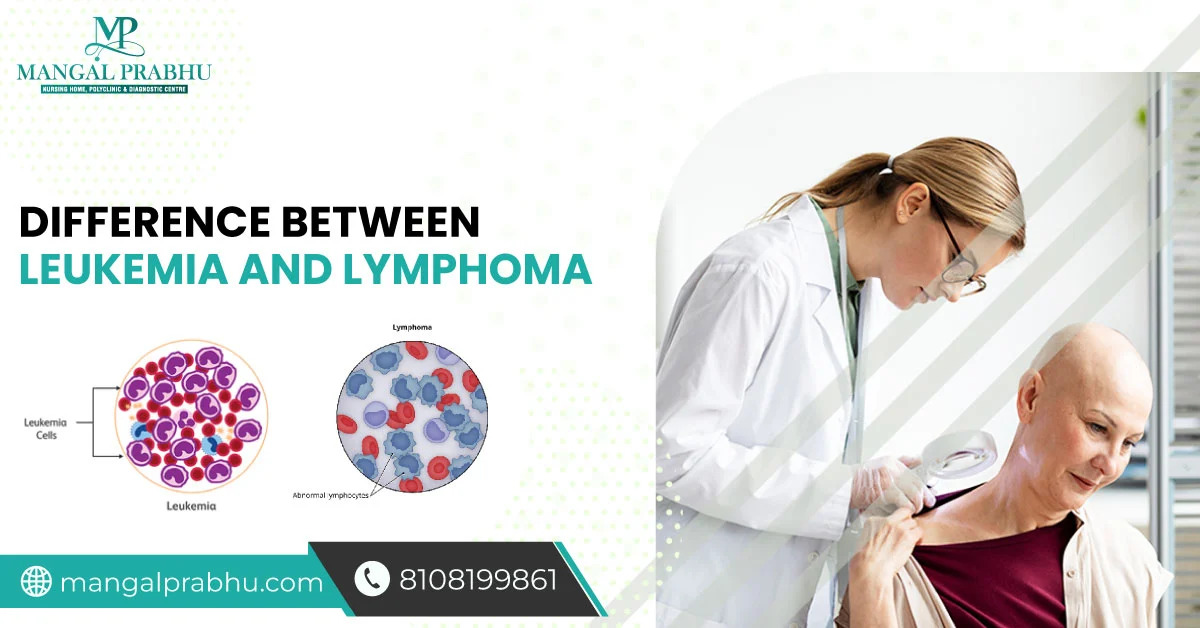
Difference Between Leukemia and Lymphoma
Cancers that involve the blood and bone marrow including leukemia and lymphoma. Despite their common origin in the cells that form blood, leukemia and lymphoma differ in various ways such as symptoms, diagnosis, and treatment options. By exploring these similarities and differences, this article will provide patients with knowledge about their specific kinds of blood cancer that can lead them to an appropriate Hematologist in Navi Mumbai.
Definition and Types
Leukemia commences in the bone marrow and causes an excessive growth of white blood cells known as leukocytes or leukemia cells. The primary distinctions lie in acute vs. chronic forms depending on which type of cells they affect: lymphocytes or myeloid cells.
Lymphoma occurs when there is proliferation of lymphocytes within the lymph nodes as well as other tissues that are found outside of bone marrow. The latter often presents with localized bands or sheets, while the former contains scattered cells among fibrous tissues or has a mixed cellularity pattern.
Causes and Risk Factors
People have still not known what causes both of these diseases before.Leukemia occurs when the genetic composition of the cells changes randomly while in Lymphoma, cases have been recorded where it was evident that certain infectious agents like Epstein Barr virus (EBV)and Human Immunodeficiency Virus(HIV)led to the disease.
Some individuals are more predisposed to these two infections due to age, and family lineage hence leading to a weaker body defence in fighting off infections as seen in these two illnesses.
Symptoms and Diagnosis
Fever, fatigue, bone/joint pain and frequent infections are the crucial symptoms of Leukemia. Other signs of Leukemia include an increase in malignant white cells in the blood because they destroy healthy cells inside their crowded zone.
Enlarged lymph nodes, weight loss, night sweats etc. are likely to be signs of Lymphoma depending on which part of the lymphatic system is under attack. Blood tests plus bone marrow biopsy, as well as several scans for an accurate diagnosis on the specific type of disease. Such tests can be administered by a Hematologist in Navi Mumbai.
Treatment Options
For each of the conditions above, treatment may include chemotherapy, immunotherapy, targeted therapy, radiotherapy or stem cell transplant depending on the cancer type and stage.
Leukemia/lymphoma cell death is brought about by some chemotherapy drugs used for chemotherapy administered over many months.
There are a brand new range of targeted therapies that attack particular changes found on some cells. The main focus of any treatment is getting rid of the disease while experiencing the least possible effects which would otherwise have been exterminating the patient.
Prognosis and Survival Rates
The prognosis is based on various other factors such as the kind of disease, the age of the person diagnosed with certain cancer among others in general each type has its own survival rates. For instance, patients seem to do better if they have leukemia than some forms of lymphoma.
Leukemia has a five-year survival rate of about 60% if totally treated whereas the one for Hodgkin’s disease is between 50 and 70%; for some non-Hodgkin’s, this goes down to 50%. Henceforth, when one completes treatment, it is essential to have follow-up visits with the hematologist at Navi Mumbai.
Conclusion
Though they come from the same source (cells) in the family tree of body production called blood, there are noticeable distinctions between Leukemia and Lymphoma with regard to health indicators hence how they are determined and perceived by doctors.
Survival chances could be boosted immensely provided that one is diagnosed with either of them earlier and treated according to one’s personal peculiarities by a seasoned Hematologist who does Leukemia and Lymphoma Treatment in Navi Mumbai. Regular screenings, good life habits and immediate medical care upon noticing something amiss have appreciable importance in averting their occurrence.
